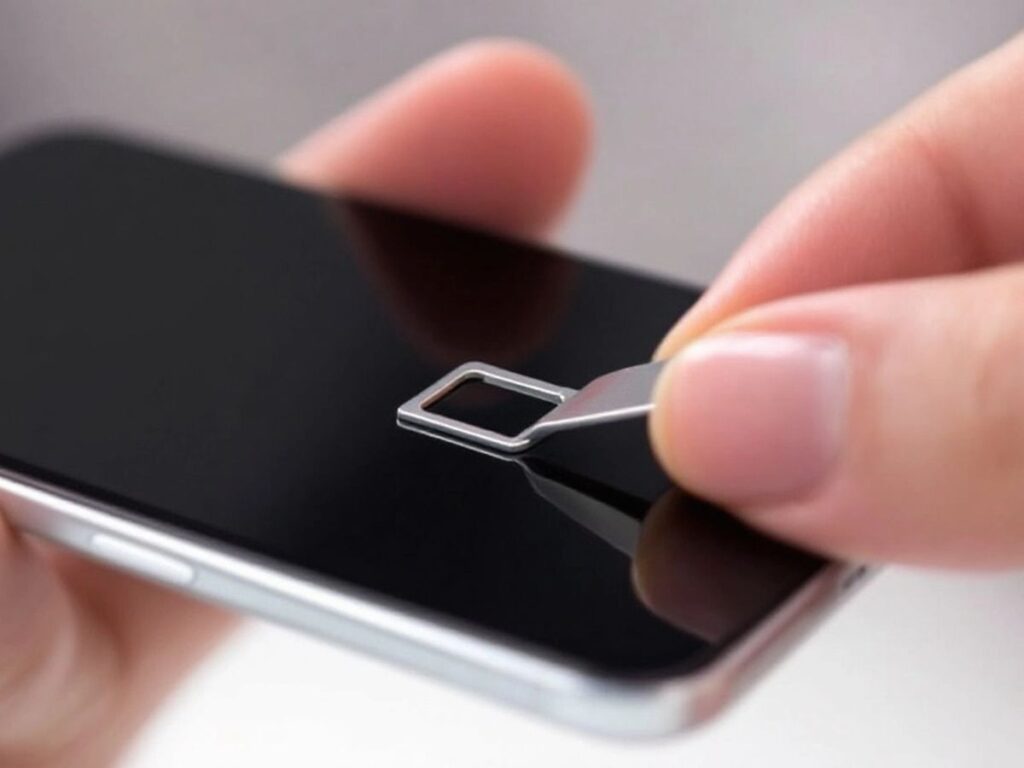How to Pop Out Sim Card: A Step-by-Step Guide for Every Phone
Removing or inserting a SIM card in your phone may seem tricky, but it’s a straightforward process once you know the steps. This guide will walk you through everything you need to do, whether you’re using an iPhone, an Android device, or an older phone model. Understanding how to handle your SIM card properly can help you avoid issues and ensure your phone works smoothly.
Key Takeaways
- Always power off your phone before removing the SIM card to prevent damage.
- Use a SIM ejector tool or a paperclip to open the SIM card tray safely.
- Check the orientation of the SIM card before inserting it to avoid damage.
- If your SIM card isn’t recognized, make sure it’s properly installed and activated.
- Keep your SIM card and tray clean to ensure good connectivity.
Understanding the Importance of a SIM Card
What is a SIM Card?
A SIM card, or Subscriber Identity Module, is a small chip that connects your phone to a mobile network. It holds important information like your phone number and contacts, allowing your device to communicate with the network.
Why Your Phone Needs a SIM Card
Without a SIM card, your phone can’t make calls, send texts, or use mobile data. It’s like a key that unlocks your phone’s full potential. Here are some key points:
- Connects to mobile networks
- Enables calls and texts
- Allows internet access
Different Types of SIM Cards
There are various types of SIM cards, including:
- Standard SIM
- Micro SIM
- Nano SIM
Each type fits different devices, so it’s important to know which one your phone uses.
Understanding your SIM card is essential for keeping your phone functional and connected. This guide provides a comprehensive, step-by-step approach for beginners to create pop-up cards. It covers essential materials, techniques, and tips to help users craft unique and engaging cards. Ideal for those looking to enhance their card-making skills.
Preparing Your Device for SIM Card Removal
Before you can successfully remove your SIM card, it’s essential to prepare your device properly. This ensures a smooth process and helps avoid any potential damage. Here’s how to get started:
Powering Off Your Device
The first step is to power off your device completely. This prevents any electrical issues while you handle the SIM card. To do this, press and hold the power button until the screen goes blank. Once your device is off, you can safely proceed to the next steps.
Gathering Necessary Tools
Before you begin, make sure you have the right tools:
- A SIM card ejector tool or a small paperclip
- A clean, lint-free cloth
- Your device’s user manual (if needed)
These tools will help you access the SIM card slot and ensure a smooth removal process.
Identifying the SIM Card Slot
To find the SIM card slot, look for a small tray or compartment on the side or back of your device. If you’re unsure, consult your user manual for specific instructions. Knowing where the slot is located will make the removal process much easier.
Preparing your device properly is crucial for a successful SIM card removal. Taking these steps will help you avoid any complications.
By following these steps, you’ll be ready to safely remove your SIM card and explore the world of Cut Pop Up products, where creativity meets functionality in every card design!
Removing the SIM Card from an iPhone
Locating the SIM Card Tray on iPhones
To start, you need to find the SIM card tray on your iPhone. This tray is usually located on the left side of the device. If you have an iPhone model from the 14 series or later, note that it may not have a SIM tray if purchased in the U.S. For other models, look for a small hole next to the tray.
Using a SIM Ejector Tool
Once you’ve located the tray, you’ll need a SIM ejector tool or a small paperclip. Insert the tool into the hole next to the tray and gently push until the tray pops out. Be careful not to force it, as this could damage your device.
Handling the SIM Card Carefully
After the tray is out, you can see the SIM card. Gently lift it out, making sure to hold it by the edges. Avoid touching the metal contacts to prevent any damage. If you’re replacing it, take note of the orientation; the card will only fit one way due to a small notch.
Remember, handling your SIM card with care is essential to avoid any issues with your phone’s connectivity.
By following these steps, you can easily remove the SIM card from your iPhone, ensuring a smooth transition whether you’re switching cards or troubleshooting issues. Cut Pop Up cards can add a personal touch to your communications, making every moment special!
Removing the SIM Card from an Android Phone

Finding the SIM Card Slot on Android Devices
To start, you need to locate the SIM card slot on your Android device. This slot can be found on the side or top of the phone, depending on the model. If you’re unsure, check your user manual for guidance. Here’s a quick list of common locations:
- Samsung Galaxy: Bottom-left edge
- Google Pixel: Bottom-right edge
- OnePlus: Side of the device
Using Alternative Tools for SIM Removal
Most Android devices come with a SIM-eject tool, but if you don’t have one, a small paperclip works just as well. Here’s how to use it:
- Power off your device to avoid any damage.
- Insert the tool into the small hole next to the SIM tray.
- Push gently until the tray pops out.
Steps to Safely Eject the SIM Card
Once you have the tray out, follow these steps to remove the SIM card:
- Lift the SIM card out of the tray carefully.
- If you’re inserting a new SIM, align it correctly in the tray.
- Push the tray back into the device until it clicks into place.
Remember, handling your SIM card with care is essential to avoid damage. A damaged SIM card can lead to connectivity issues.
Dealing with SIM Cards in Older Phone Models

Older phone models can present unique challenges when it comes to handling SIM cards. Understanding how to access and manage these cards is essential for maintaining your device’s functionality.
Accessing the SIM Card Slot in Feature Phones
Feature phones often have a different design compared to modern smartphones. Here’s how to access the SIM card slot:
- Locate the back cover: Most feature phones have a removable back cover. Gently pry it off to reveal the battery and SIM card slot.
- Remove the battery: If necessary, take out the battery to access the SIM card.
- Find the SIM card slot: Look for a small slot where the SIM card is inserted. It may be labeled for clarity.
Removing the Back Cover
To remove the back cover safely:
- Use a soft touch: Avoid using excessive force to prevent breaking the cover.
- Check for clips: Some models have clips that need to be pressed to release the cover.
- Be gentle: Handle the cover carefully to avoid damaging any internal components.
Handling SIM Cards in Non-Smartphones
When dealing with SIM cards in non-smartphones, keep these tips in mind:
- Inspect for damage: Always check the SIM card for scratches or dirt before reinserting it.
- Keep it clean: Use a soft cloth to wipe the card and tray, ensuring a good connection.
- Store safely: If you have spare SIM cards, keep them in a safe place to avoid loss or damage.
Remember, handling your SIM card with care is crucial to avoid any issues. Whether you’re switching cards or troubleshooting, a little attention goes a long way in keeping your device running smoothly.
By understanding these steps, you can effectively manage SIM cards in older phone models, ensuring they continue to serve you well. And while you’re at it, consider exploring Pop Up Cards for creative ways to express your thoughts and feelings. They add a personal touch to any occasion, making your messages memorable!
Troubleshooting Common SIM Card Issues
When your phone isn’t recognizing your SIM card, it can be frustrating. Here are some common issues and how to fix them:
SIM Card Not Recognized
If your phone displays a message saying it cannot find the SIM card, first check if the card is inserted correctly. Make sure the SIM card is aligned properly in the tray. If it still doesn’t work, try reinserting it. Sometimes, the tray can be bent or damaged, which can cause this issue. If you suspect this, you might need to replace the tray.
Damaged SIM Card
A damaged SIM card can lead to connectivity problems. Inspect the card for any visible damage, such as cracks or scratches. If you notice any, it’s best to contact your mobile service provider for a replacement. Do SIM cards go bad? Yes, they can wear out over time, so regular checks are important.
No Service After SIM Card Installation
If you’ve just installed a new SIM card and there’s no service, ensure that the card is activated. Sometimes, new cards need to be activated through your carrier’s website or app. If the card is activated and you still have no service, try restarting your phone. This can help refresh the connection to the network.
Quick Tips:
- Always power off your device before removing or inserting a SIM card.
- Keep the SIM card and tray clean to avoid connectivity issues.
- If problems persist, consider visiting a phone repair shop for professional help.
Regular maintenance of your SIM card can prevent many common issues. A clean and undamaged SIM card ensures a smooth user experience!
Inserting a New SIM Card into Your Phone
Aligning the SIM Card Correctly
Inserting a new SIM card into your phone is a straightforward process, but it’s important to do it correctly. Make sure to align the card properly with the tray. Look for a small notch on the SIM card; this indicates the correct orientation. Here’s how to do it:
- Power off your device to avoid any electrical issues.
- Locate the SIM card tray on your phone. It usually has a small hole next to it.
- Use a SIM ejector tool or a paperclip to gently push into the hole. The tray should pop out easily.
- Remove the tray and place the SIM card in the correct position, ensuring it’s flush with the tray.
- Insert the tray back into the phone, making sure it’s secure.
Securing the SIM Card Tray
After inserting the SIM card, it’s crucial to ensure that the tray is properly secured. Gently push the tray back into the slot until you hear a click. This sound indicates that the tray is locked in place. If you feel resistance, double-check the orientation of the tray before pushing it in further.
Powering On and Testing the Device
Once the SIM card is in place, power on your device. It may take a moment, but you should see signal bars indicating that the SIM card is recognized. If you don’t see any service, try removing the SIM card and repeating the steps to ensure everything is aligned correctly.
Remember, proper alignment is key to avoid damaging your SIM card or device. Taking a moment to check can save you from future headaches!
Maintaining Your SIM Card and Tray

Keeping your SIM card and tray in good shape is essential for a smooth phone experience. Regular maintenance can prevent connectivity issues and ensure your device works well. Here’s how to do it:
Cleaning the SIM Card and Tray
- Turn off your device before starting.
- Use a clean, lint-free cloth to gently wipe the metal contacts on the SIM card.
- If there’s stubborn dirt, use a little isopropyl alcohol on the cloth, but be careful not to touch other parts of the card.
- Let the SIM card air dry completely before reinserting it.
Inspecting for Damage
- Check the SIM card for scratches, bends, or any visible wear.
- Look at the tray for dust or debris that could affect connectivity.
- If you see any damage, consider getting a replacement from your carrier.
Storing Spare SIM Cards Safely
- Keep spare SIM cards in a protective case to avoid damage.
- Label them if you have different cards for various devices or countries.
- Store them in a cool, dry place to prevent any moisture damage.
Taking care of your SIM card and tray can help you avoid frustrating issues later. A little attention goes a long way in keeping your device connected and functional!
Understanding SIM Card Adapters and Dual SIM Phones
What are SIM Card Adapters?
SIM card adapters are handy tools that allow you to use different sizes of SIM cards in your phone. They help you fit a smaller SIM card into a larger slot, ensuring compatibility across various devices. Using an adapter can save you from buying a new SIM card. Here are some common types of SIM card sizes:
- Standard SIM: The largest size, often used in older phones.
- Micro SIM: A smaller version, used in many smartphones.
- Nano SIM: The smallest size, found in the latest devices.
| SIM Card Type | Dimensions (mm) |
|---|---|
| Standard | 85.60 x 53.98 |
| Micro | 15.00 x 12.00 |
| Nano | 12.30 x 8.80 |
Using Dual SIM Phones
Dual SIM phones allow you to use two SIM cards simultaneously. This feature is great for people who want to separate work and personal calls or travel internationally without changing SIMs. Here are some benefits of using a dual SIM phone:
- Flexibility: Switch between two numbers easily.
- Cost Savings: Use local SIMs while traveling to avoid roaming charges.
- Better Coverage: Access different networks for better signal strength.
Having a dual SIM phone can enhance your connectivity and save you money, especially when traveling.
In conclusion, understanding SIM card adapters and dual SIM phones can greatly improve your mobile experience. Whether you’re looking to adapt your SIM card or enjoy the benefits of dual connectivity, these tools are essential for modern phone users. Explore options like Cut Pop Up for creative designs that can enhance your card experience!
When to Seek Professional Help
Identifying Complex Issues
Sometimes, you might face problems that are too tricky to handle on your own. If your SIM card is stuck or your phone won’t recognize it, it’s a good idea to seek help. Don’t hesitate to ask for assistance!
Visiting a Phone Repair Shop
If you’re unsure about how to proceed, visiting a local phone repair shop can be a smart choice. They have the right tools and expertise to help you out. Here are some reasons to consider this option:
- They can quickly diagnose the problem.
- They have experience with various phone models.
- They can provide solutions that you might not have thought of.
Contacting Your Carrier for Support
Your mobile carrier can also be a valuable resource. They can assist with issues related to your SIM card and account. Here’s what you can do:
- Call their customer service.
- Visit their website for troubleshooting tips.
- Go to a local store for in-person help.
Seeking professional help can save you time and frustration. It’s always better to get expert advice when you’re unsure about a problem.
In conclusion, while many SIM card issues can be resolved at home, don’t hesitate to reach out for professional help when needed. It’s better to be safe than sorry!
Tips for Traveling with Your SIM Card
Traveling can be exciting, but it’s essential to keep your SIM card in mind. Here are some tips to ensure you stay connected while exploring new places.
Using International SIM Cards
- Sign up for the right international phone plan: Before you leave, check with your carrier about international plans that suit your needs.
- Buy a local SIM card in your destination: This can often be the most cost-effective way to stay connected. You can find local SIM cards at airports or convenience stores.
- Utilize an eSIM card: If your phone supports it, an eSIM can be a convenient option for switching networks without needing a physical card.
Avoiding Roaming Charges
- Check your current plan: Understand what your carrier offers for international roaming.
- Consider a prepaid SIM: This can help you avoid unexpected charges while traveling.
- Turn off data roaming: If you’re not using a local SIM, make sure to disable data roaming to prevent extra fees.
Keeping Your SIM Card Safe While Traveling
- Store it securely: Use a small case or pouch to keep your SIM card safe when not in use.
- Avoid losing it: When switching SIM cards, do it in a safe place to prevent dropping it.
- Label your SIM card: If you have multiple cards, labeling them can help you keep track of which is which.
Remember, your SIM card is your gateway to staying connected while traveling. Treat it with care, and you’ll enjoy a hassle-free experience!
When you travel, keeping your SIM card safe is super important. Make sure to store it in a secure place and avoid losing it. If you want to learn more about how to manage your SIM card while on the go, check out our website for helpful tips and tricks!
Final Thoughts on SIM Card Management
In conclusion, popping out a SIM card may seem tricky at first, but with the right steps, it becomes a simple task. Remember to always turn off your phone before you start, and use the proper tools to avoid any damage. Whether you’re switching carriers or upgrading your device, knowing how to handle your SIM card is essential. With this guide, you can confidently manage your SIM card, ensuring your phone stays connected and functional. So, the next time you need to change your SIM, just follow these steps, and you’ll be good to go!
Frequently Asked Questions
What is a SIM card?
A SIM card is a small chip that lets your phone connect to a mobile network. It stores your phone number and other important information.
Why do I need to remove my SIM card?
You might need to remove your SIM card to switch to a new phone, replace a damaged card, or travel internationally.
How do I find the SIM card slot on my phone?
The SIM card slot is usually on the side or back of your phone. Check your phone’s manual if you’re not sure.
Can I use a paperclip to eject the SIM card tray?
Yes, a straightened paperclip works great to open the SIM card tray if you don’t have the special ejector tool.
What should I do if my SIM card is not recognized?
If your SIM card isn’t recognized, try removing it and reinserting it. Make sure it’s properly aligned in the tray.
How do I insert a new SIM card?
Align the new SIM card with the tray’s notches and gently slide it in until it fits snugly.
Is it safe to remove the SIM card while the phone is on?
It’s best to power off your phone before removing the SIM card to avoid any potential damage.
What if my SIM card gets damaged?
If your SIM card is damaged, you will need to get a replacement from your mobile carrier.









The way you broke this down is incredibly helpful.
Электрическая дератизация – это способ борьбы с крысами и мышами при помощи высоковольтного электричества.
Every paragraph is a step closer to understanding — you’ve crafted this piece with such care and insight.
Автор представляет важные факты и обстоятельства, сопровождая их объективным анализом.